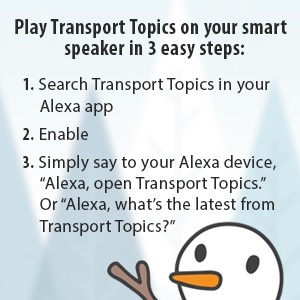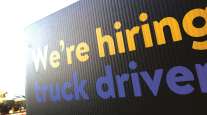Driver Retention Boosted by Recognition, Opportunity, Experts Say
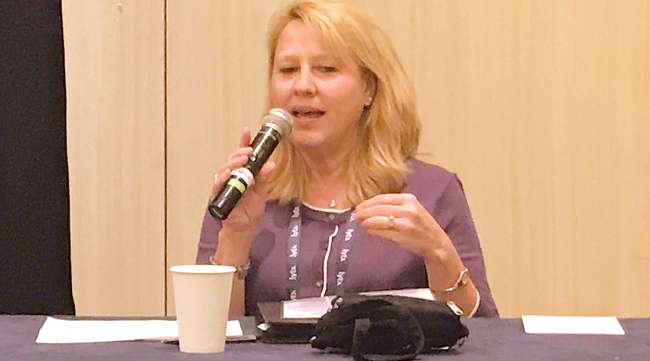
SAN DIEGO — Creative methods for recruiting new hires and recognizing existing drivers’ efforts can help commercial fleets keep their vehicles’ seats filled, experts said here during the Lytx User Group Conference.
For Brenny Transportation founder and President Joyce Brenny, a familiar personality test has uncovered a trend that helps guide her hiring.
“We do a Myers-Briggs personality profile when we hire any individual,” she said during a panel focused on “out-of-the-box” retention strategies, and noted that 75% of her drivers fall into one of two personality types on the test.
“Both of those personalities are very honest and loyal,” Brenny said, noting that she can now get a sense during the interview process if a candidate is likely to fall into one of these categories.
Once hired, Brenny makes sure her employees’ families know the company appreciates that person’s work — as well as the role family can play in their success — with an annual week of appreciation for trucking families, complete with events and outreach that get employees’ families involved.
At transit company Keolis Transit America’s Las Vegas location, a wall of photographs is dedicated to recognizing drivers who have logged at least 1 million safe miles, while the operators’ lounge features clippings of letters and other tokens of appreciation drivers have received over the years, said Kim Bush, a customer service and quality assurance manager.
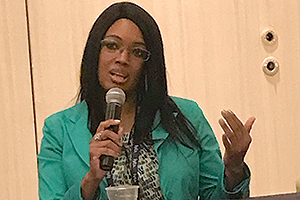
Bush by Joe Howard/Transport Topics
“Anytime they get any kudos, a clip goes somewhere — the operators’ lounge has all of this stuff everywhere,” she said. “Operators love to see their name and face get that recognition. We need to do a better job of recognizing [them].”
Similarly, Brenny Transportation has a “Haul of Fame” with photos of notable jobs the company has done, Brenny said.
Offering drivers a career development program is a strategy Oklahoma-based concrete company Dolese uses to help it compete in a talent market when unemployment is low, said Gaylan Towle, the company’s operations manager.
More From the Conference
“We have a driver career path program where they can learn safety, operational things and shop things,” he said. “We’re trying to make them more knowledgeable, because the more knowledgeable they are, the better they are for us.” And the more pay they get, he noted, as drivers who complete the program are given raises.
In one case, Towle said a long-tenured driver was promoted into a mentoring role in which he helps drivers improve performance and overcome challenges.
Helping former members of the military overcome the challenge of adjusting to civilian life is one that Lt. Michael Crabb of the Orange County (Fla.) Sheriff’s Department has confronted, and advised fleets trying to help former service members transition to truck driving jobs to build a sense of belonging to help them along.
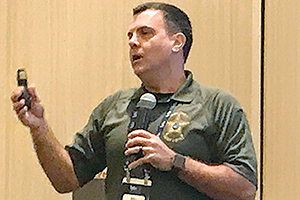
Crabb by Joe Howard/Transport Topics
“They are missing that camaraderie,” he said, noting that former military members might face difficulty shifting from working alongside fellow service members to driving a truck and being disconnected from others. “If you can create an environment that gives them camaraderie — smaller, cohesive units that give them camaraderie — that’s where you’ll excel in retaining those military guys,” he said.
Crabb also offered some advice for fleets looking to recruit younger workers. While the paramilitary structure of the police department would be familiar to former service members, the top-down, follow-orders nature of the work wasn’t sitting well with younger workers, and forced some change, Crabb noted.
“The big change we made was in communication,” Crabb said. “It used to be no one asked questions, but millennials ask ‘why’ and sometimes the ‘why’ is not a bad thing — it helps you view processes that you can do better.” Eventually, this shift led to organizational change, he noted. “Sergeants had to be trained to not to yell at the youngsters, because they’re just asking ‘why.’ ”
Communication channels for recruitment also have evolved, as younger people entering the trucking workforce are much more connected to electronic media than earlier generations, Paul Rasmussen, senior vice president of fleet development for Paschall Truck Lines, said during a session focused on recruiting younger drivers.
“Our advertising efforts are more focused on multiple touchpoints now, with lots of engaging content,” he said. “We have text and e-mail campaigns, and we are also now adjusting our onboarding efforts.” Plus, while he noted that phone calls are the last step in the process, the company is training recruiters to spend more time getting to know prospective employees.
“It is about training your recruiters on how to recruit,” he said. “On the phone call side, we train them to extend call times longer. Newer recruiters talk for about 2½ minutes, but we’re trying to get that to four minutes. We’re trying to get them to ask more questions about the driver, not just pitch the company and pay.”
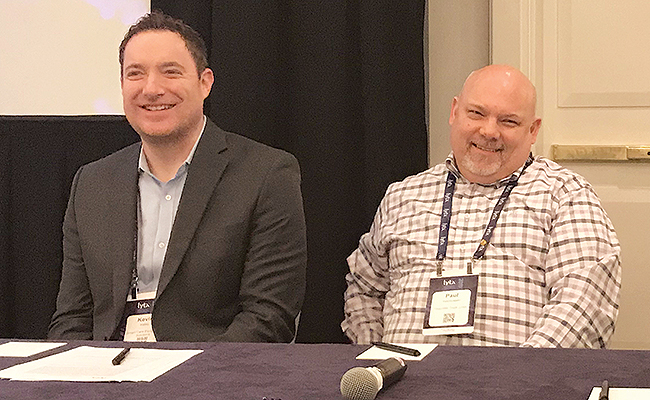
Kevin Kelley of Smart Care Equipment Solutions (left) and Paul Rasmussen of Paschall Truck Lines by Joe Howard/Transport Topics
That sort of engagement is key, added Kevin Kelley, safety and health director for Smart Care Equipment Solutions.
“Happiness can be bought with a bottle of wine, but the engagement is what we really have to do and it cannot be just through the current tradition of device-oriented communication,” he said. “It’s got to be a combination of hands-on and the devices because, as much as millennials are device-driven, they still want that interpersonal connection — they still want that interaction. In our remote workforce, they’re getting no touchpoint whatsoever, unless we drive it. They surprised me; they want it more than you think.”


